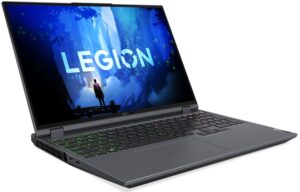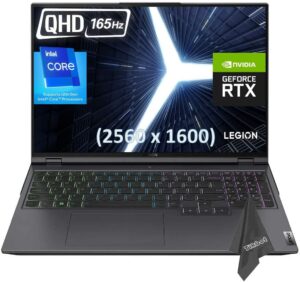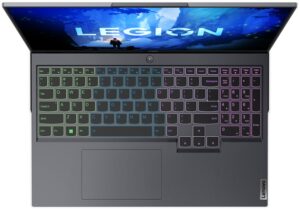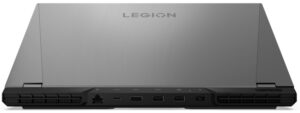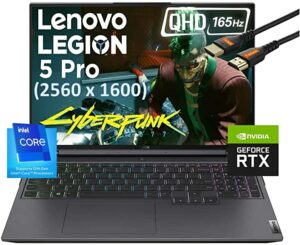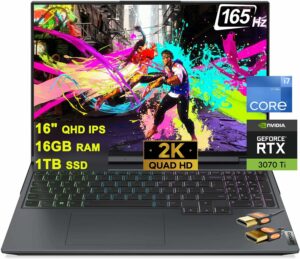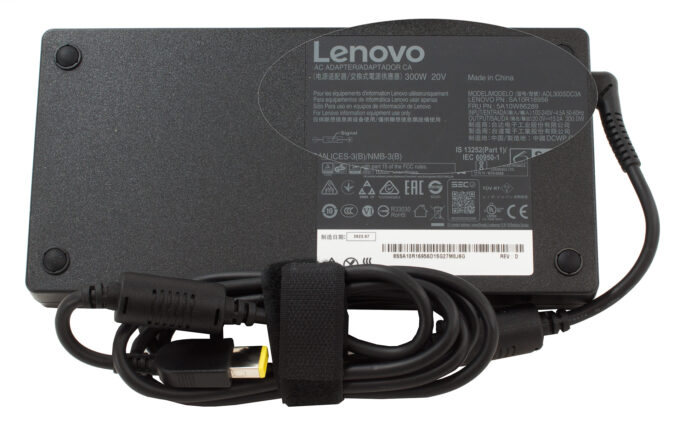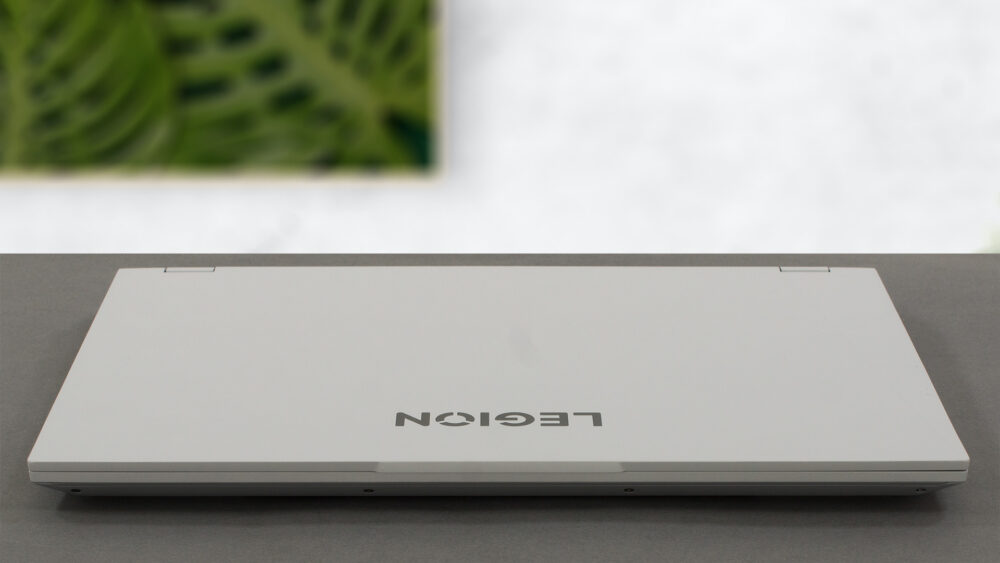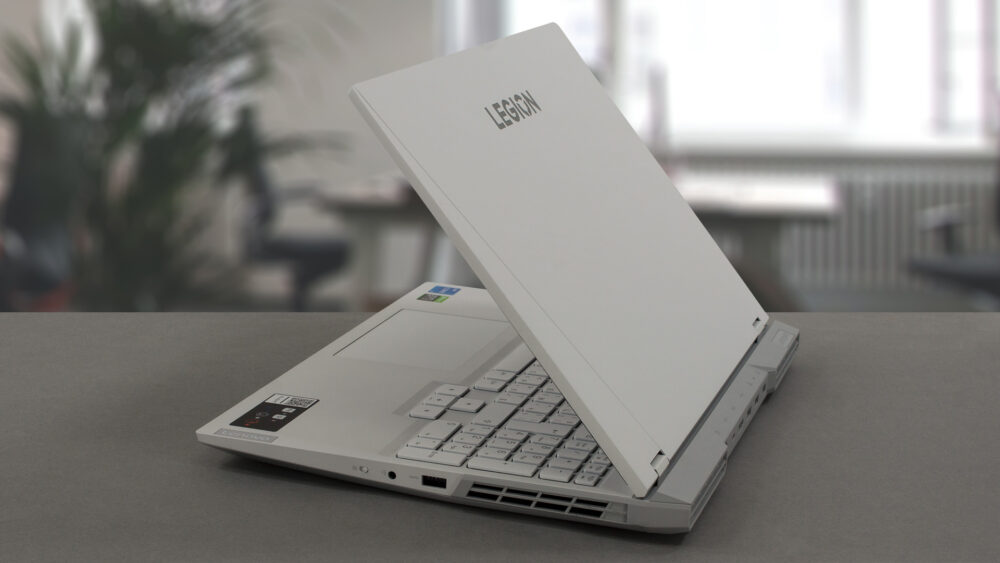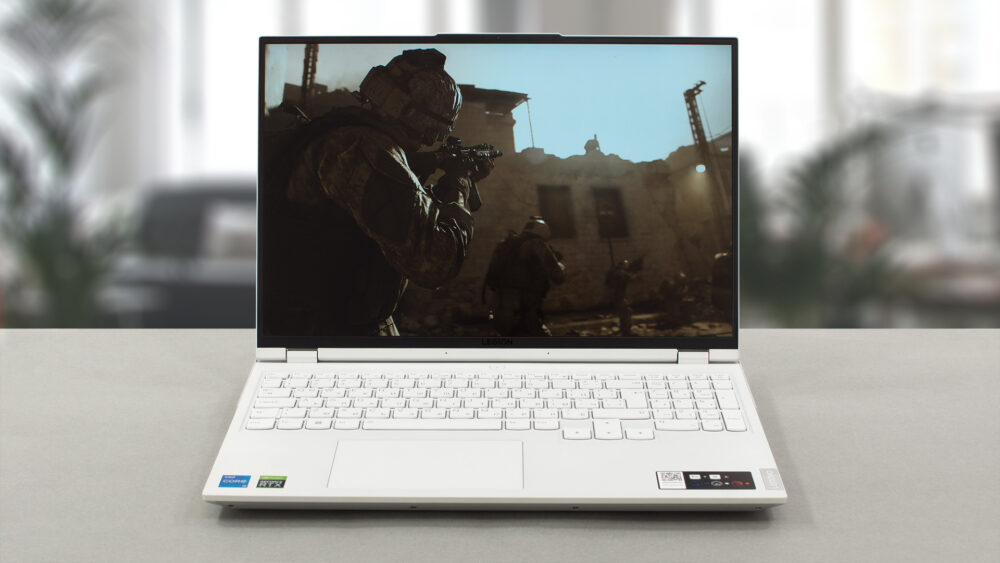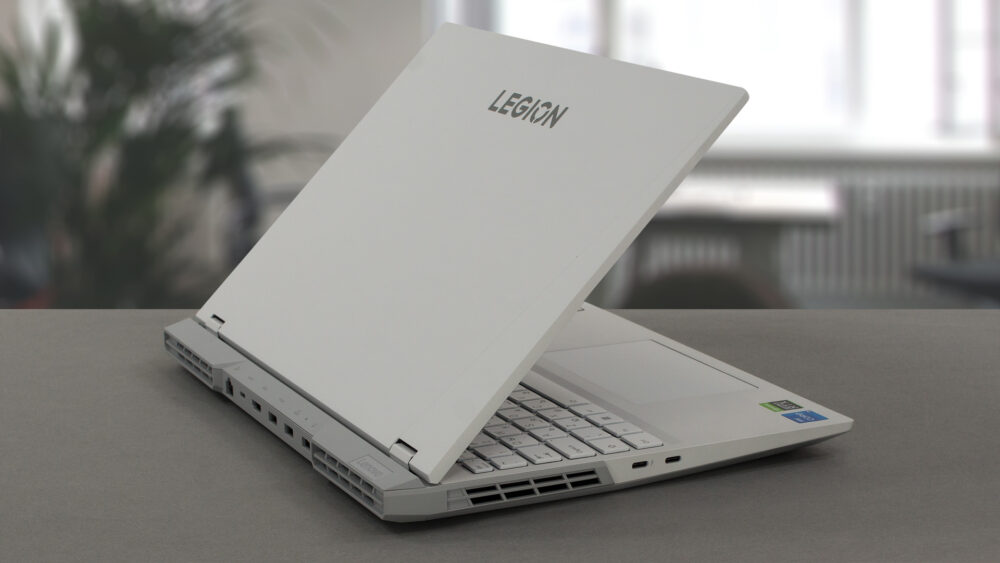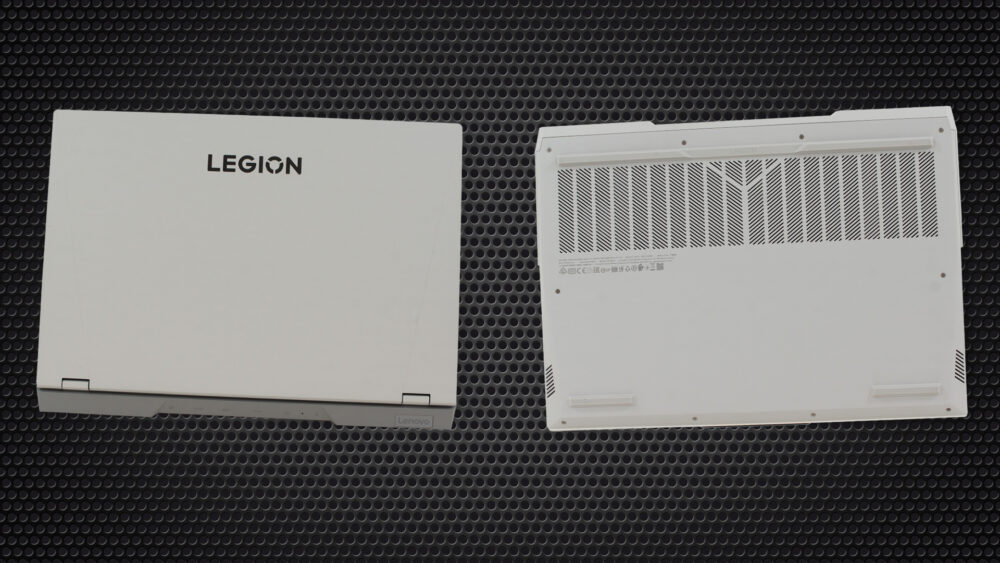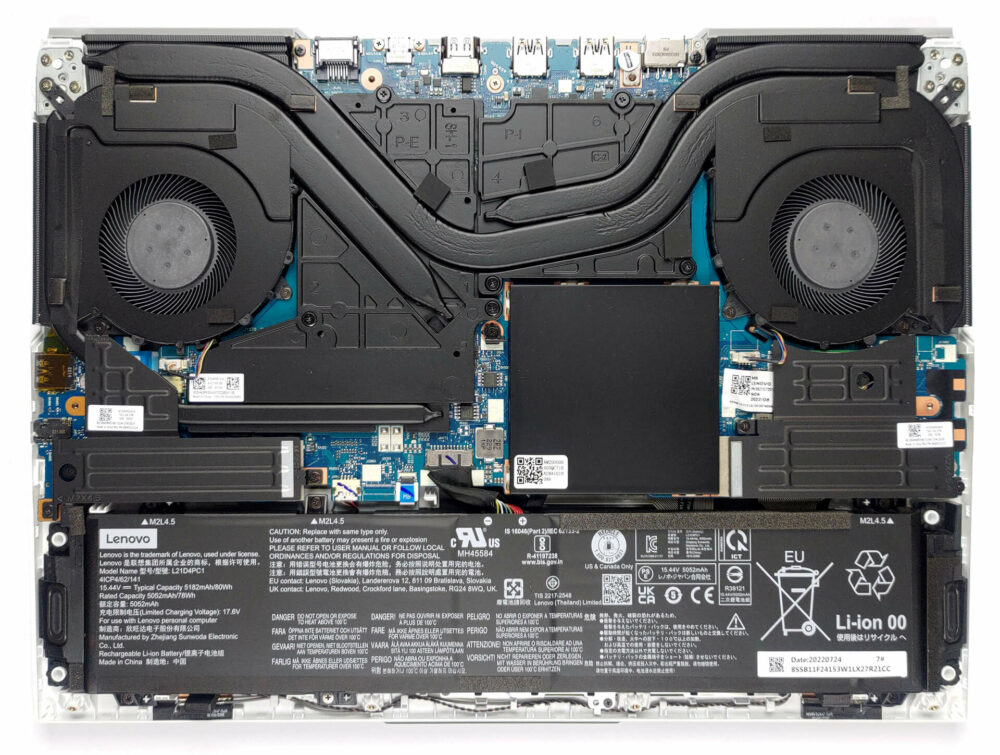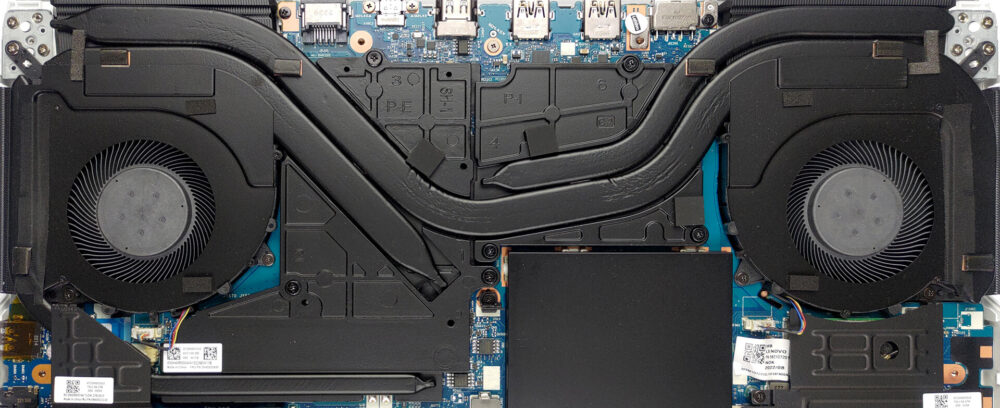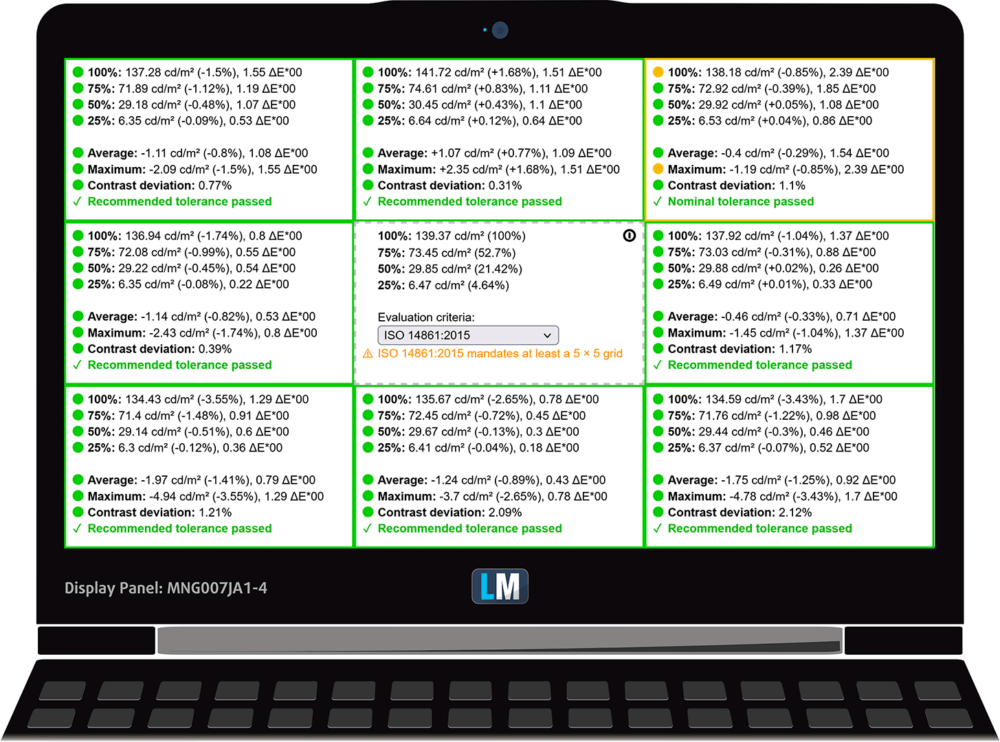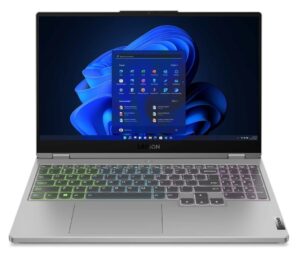Lenovo Legion 5i Pro (16″, 2022) review
 Who, in their right might, won’t consider the Legion 5 Pro as their next gaming device? That’s right, currently, no such person exists. And this is because Lenovo proved that its latest gaming notebook is not limited to playing games only. Instead, you can do content creation, Web development, and more.
Who, in their right might, won’t consider the Legion 5 Pro as their next gaming device? That’s right, currently, no such person exists. And this is because Lenovo proved that its latest gaming notebook is not limited to playing games only. Instead, you can do content creation, Web development, and more.
The main reason for that is the usage of a 16:10 display. Naturally, it offers more vertical space, which lets you see more of the page. This is why the display is also slightly bigger than the “ordinary” Legion 5 – 16 inches. By the way, we haven’t yet introduced this bad boy. It is the Legion 5i Pro (16″, 2022), and was created by Lenovo to narrow the gap between the Legion 5 and the Legion 7 gaming devices.
In addition to that, it essentially created a laptop that may become a pillar in the company’s portfolio of devices. It has combined all of the superpowers of the company’s top lineups – the keyboard of the ThinkPads, the performance of the Legion, the style of the IdeaPad, and the versatility of the X1 series. What else can you possibly need?
Well, first of all, you have to choose between Intel and AMD. Although there are reasons for choosing either of the brands, for this review, we have picked the Intel model. Naturally, it comes with Intel’s 12th Gen processors, and graphics cards from NVIDIA. The top configuration includes the 150W RTX 3070 Ti, so we are talking about a ton of horsepower.
Indeed, this will require a capable cooling solution, but before we see how the laptop performed, we want to tell you about the visual appeal of the machine. Let’s get started!
You can check the prices and configurations in our Specs System: https://laptopmedia.com/series/lenovo-legion-5-pro-5i-pro-16-intel-2022/
Contents
- Specs Sheet
- What’s in the box?
- Design and construction
- Disassembly, upgrade options and maintenance
- Display quality
- PWM (Screen flickering)
- Buy our profiles
- Sound
- Drivers
- Battery
- CPU options
- GPU options
- Gaming tests
- [eBook Guide + Tools] How to MAX OUT your Lenovo Legion 5i Pro (16″, 2022)
- Temperatures and comfort
- Verdict
Specs Sheet
- HDD/SSD
- up to 4000GB SSD
- M.2 Slot
- 2x 2280 PCIe NVMe 4.0 x4 See photo
- RAM
- up to 64GB
- OS
- Windows 11 Home, Windows 11 Pro, Windows 10 Home
- Battery
- 80Wh
- Body material
- Plastic / Polycarbonate, Aluminum, Magnesium alloy
- Dimensions
- 359.9 x 264.4 x 19.9 mm (14.17" x 10.41" x 0.78")
- Weight
- 2.49 kg (5.5 lbs)
- Ports and connectivity
- 2x USB Type-A
- 3.2 Gen 1 (5 Gbps)
- 1x USB Type-A
- 3.2 Gen 1 (5 Gbps), Sleep and Charge
- 1x USB Type-C
- 3.2 Gen 2 (10 Gbps), DisplayPort
- 1x USB Type-C
- 3.2 Gen 2 (10 Gbps), Power Delivery (PD), DisplayPort
- 1x USB Type-C
- 4.0, Thunderbolt 4, DisplayPort
- HDMI
- 2.1
- Card reader
- Ethernet LAN
- 10, 100, 1000 Mbit/s
- Wi-Fi
- 802.11ax
- Bluetooth
- 5.2
- Audio jack
- 3.5mm Combo Jack
- Features
- Fingerprint reader
- Web camera
- HD
- Backlit keyboard
- Microphone
- Dual Array Microphone
- Speakers
- 2x 2W Stereo Speakers, Nahimic Audio
- Optical drive
- Security Lock slot
All Lenovo Legion 5 Pro / 5i Pro (16″ Intel, 2022) configurations
What’s in the box?
The Legion 5i Pro (16″, 2022) arrives in a black box. Inside, we see that the laptop is protected by a couple of large foam pads. In addition, you get some paper manuals, as well as a decently-sized 300W plastic cutting board. It is perfect for dried meat and cheese.
Design and construction
Once we take the laptop out of its packaging, we see that it hasn’t really changed much since last year. It still comes in two options – black and white. Obviously, we have the white one, and it looks spectacular. In a typical Legion fashion, the backside is elongated, which keeps most of the hot components away from your hands.
We were also not surprised to learn that the entire machine is made out of metal (aluminum and magnesium on some parts). Well, with the exception of the vent cover, which is plastic. Nevertheless, it seems like the laptop has lost some of its waistline, as it now has a profile of 19.9mm. But it still weighs a hefty 2.49 kilos.
Thankfully, the lid opens easily with a single hand. We see no flex from the base, while the lid cover is also one of the strongest out there. As you can see, the bezels around the 16-inch matte display are extremely thin. Nevertheless, the top one still houses an HD Web camera with no physical shutter, but one that is electronically controlled by a toggle switch on the right-hand side of the device.
Moving to the base, we see that the power button is separated from the rest of the keyboard. Its LED shines in Blue, White, or Red, depending on the Power mode you have chosen through the Vantage app. Alternatively, you can press the “Function” and “Q” keys to toggle through the performance presets.
The keyboard itself is nothing short of fantastic. It has long key travel, clicky feedback, and large key caps – especially the Arrow buttons. Furthermore, you get a NumberPad, and three options regarding the backlight – White, Blue, or 4-zone RGB.
Next, we have the touchpad. It comes with a Mylar surface, which is pretty smooth to the touch. With a size of 75 by 120mm, it sits above the average for the year (but pretty close to it). We are happy with the gliding and the tracking too.
On the bottom, you will find a couple of speaker cutouts, as well as the ventilation grill. Lenovo was not shy on exhaust grills either, as there are four – two on the back, and one on each side.
Ports
The I/O here is absolutely fantastic. On the left, you will see a Thunderbolt 4 connector and a USB Type-C 3.2 (Gen. 2) port with DisplayPort 1.4 capability. Then, on the right, you get a USB Type-A 3.2 (Gen. 1) port, an Audio jack, and the aforementioned privacy shutter toggle switch. Last, but not least, the back side houses a LAN port, another USB Type-C 3.2 (Gen. 2) port with Power Delivery 135W support and DisplayPort 1.4 connectivity, an HDMI 2.1 connector, two more USB Type-A 3.2 (Gen. 1) ports and the power connector.
Disassembly, upgrade options and maintenance
To access this notebook’s internals, you need to undo 10 Phillips-head screws. Then, pry the bottom panel with a plastic tool, but be careful when you go around the heat vents.
Inside, we find an 80Wh battery pack. It lasts for 5 hours and 30 minutes of Web browsing, or about 6 hours of video playback. To take it out, unplug the connector from the motherboard, and undo all 6 Phillips-head screws that keep it in place.
Here, you get two SODIMM slots, which work in dual-channel mode and support DDR5 modules. As for the storage, there are two M.2 PCIe x4 slots, which can work with Gen 4 SSDs.
Cooling-wise, you get one big heat pipe, shared between the CPU and GPU, as well as one more dedicated to each of them. Moreover, there is one heat pipe taking care of the graphics memory, with two heat spreaders being placed over the VRMs.
Display quality
Lenovo Legion 5i Pro (16″, 2022) in the configuration we tested has a 165Hz WUXGA IPS panel – MNG007JA1-4 (CSO1613). Its diagonal is 16-inch (40.6 cm), and the resolution is 1920 x 1200 pixels. The screen ratio is 16:10, and we are looking at a pixel density of – 141 ppi, and a pitch of 0.18 х 0.18 mm. The screen turns into Retina when viewed at distance equal to or greater than 61cm (24″) (from this distance one’s eye stops differentiating the separate pixels, and it is normal for looking at a laptop).
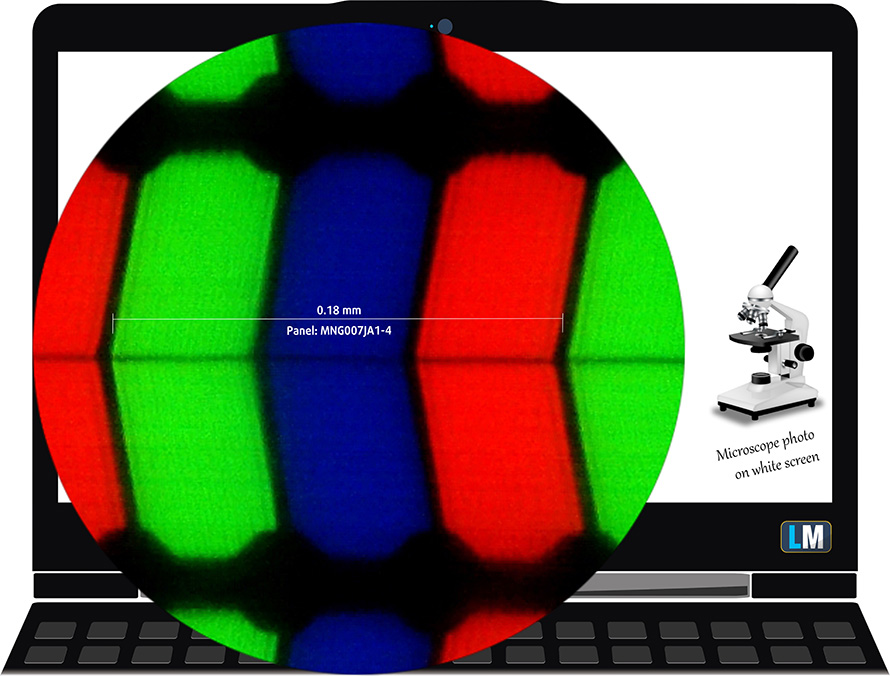
The viewing angles are excellent. We offer images at 45° to evaluate image quality.

Also, a video with locked focus and exposure.
We measured a maximum brightness of 369 nits in the middle of the screen and 355 nits as an average for the whole area, with a maximum deviation of 4%. The Correlated Color Temperature on a white screen is 6370K – slightly warmer than the optimal for the sRGB standard of 6500K.
In the illustration below you can see how the main display performs from a uniformity perspective. In other words, the leakage of light from the light source.
Values of dE2000 over 4.0 should not occur, and this parameter is one of the first you should check if you intend to use the laptop for color-sensitive work. The contrast ratio is good – 1270:1.
To make sure we are on the same page, we would like to give you a little introduction to the sRGB color gamut and the Adobe RGB. To start, there’s the CIE 1976 Uniform Chromaticity Diagram that represents the visible specter of colors by the human eye, giving you a better perception of the color gamut coverage and the color accuracy.
Inside the black triangle, you will see the standard color gamut (sRGB) that is being used by millions of people on HDTV and on the web. As for the Adobe RGB, this is used in professional cameras, monitors, etc for printing. Basically, colors inside the black triangle are used by everyone and this is the essential part of the color quality and color accuracy of a mainstream notebook.
Still, we’ve included other color spaces like the famous DCI-P3 standard used by movie studios, as well as the digital UHD Rec.2020 standard. Rec.2020, however, is still a thing of the future and it’s difficult for today’s displays to cover that well. We’ve also included the so-called Michael Pointer gamut, or Pointer’s gamut, which represents the colors that naturally occur around us every day.
The yellow dotted line shows Lenovo Legion 5i Pro (16″, 2022)’s color gamut coverage.
Its display covers 97% of the sRGB/ITU-R BT.709 (web/HDTV standard) in CIE1976.
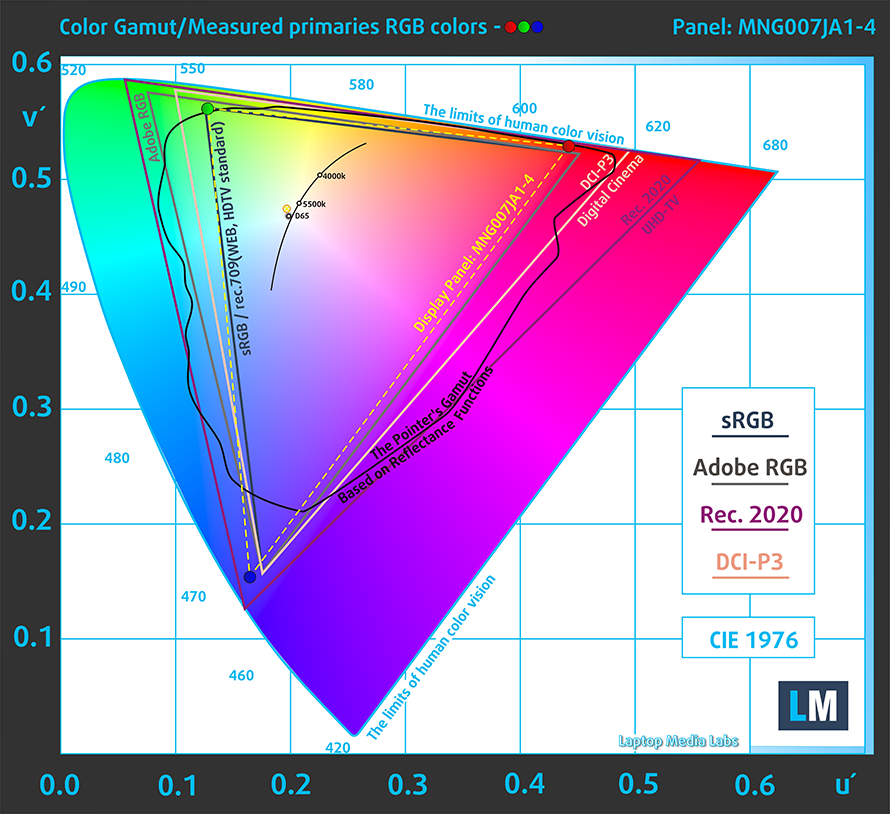
Our “Design and Gaming” profile delivers optimal color temperature (6500K) at 140 cd/m2 luminance and sRGB gamma mode.
We tested the accuracy of the display with 24 commonly used colors like light and dark human skin, blue sky, green grass, orange, etc. You can check out the results in factory condition and also, with the “Design and Gaming” profile.
Below you can compare the scores of Lenovo Legion 5i Pro (16″, 2022) with the default settings – left, and with the “Gaming and Web design” profile – right.
The next figure shows how well the display is able to reproduce really dark parts of an image, which is essential when watching movies or playing games in low ambient light.
The left side of the image represents the display with stock settings, while the right one is with the “Gaming and Web Design” profile activated. On the horizontal axis, you will find the grayscale, and on the vertical axis – the luminance of the display. On the two graphs below you can easily check for yourself how your display handles the darkest nuances but keep in mind that this also depends on the settings of your current display, the calibration, the viewing angle, and the surrounding light conditions.
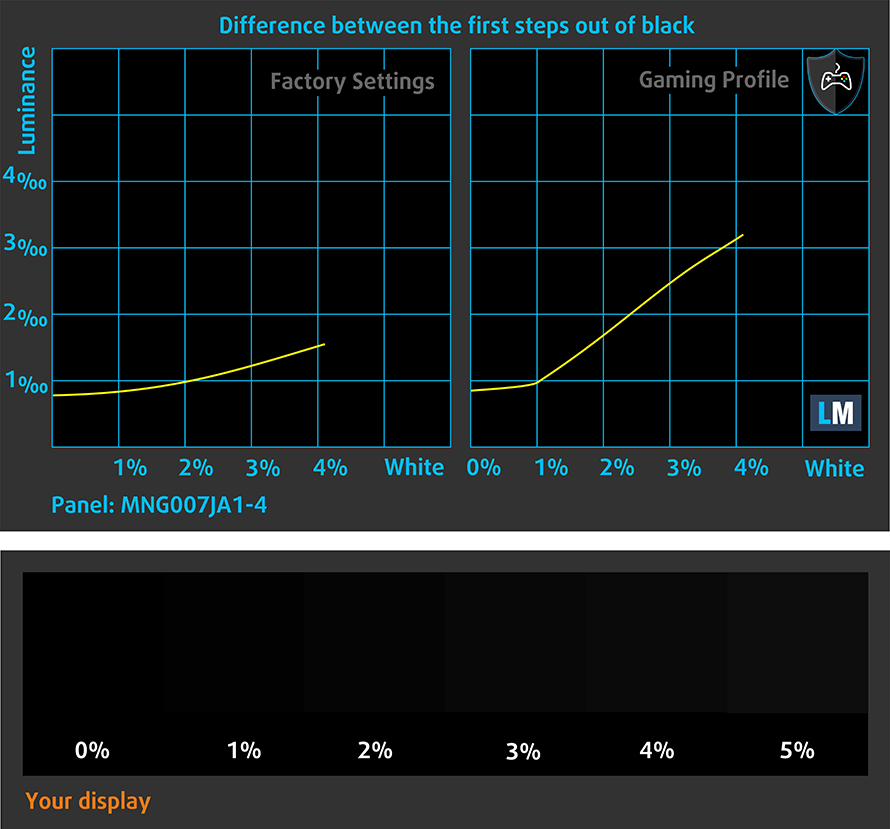
Response time (Gaming capabilities)
We test the reaction time of the pixels with the usual “black-to-white” and “white-to-black” method from 10% to 90% and vice versa.
We recorded Fall Time + Rise Time = 9 ms.
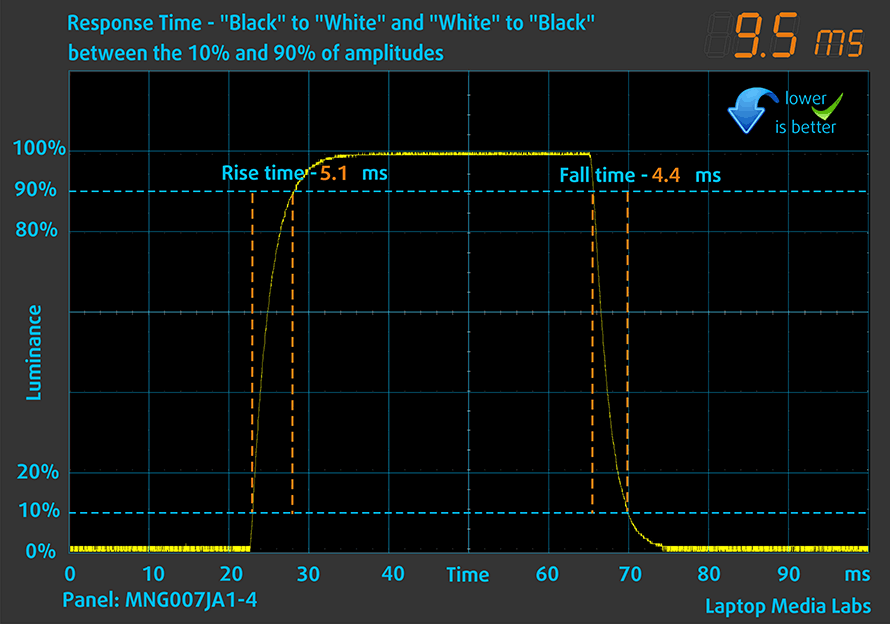
After that, we test the reaction time of the pixels with the usual “Gray-to-Gray” method from 50% White to 80% White and vice versa between 10% and 90% of the amplitude.
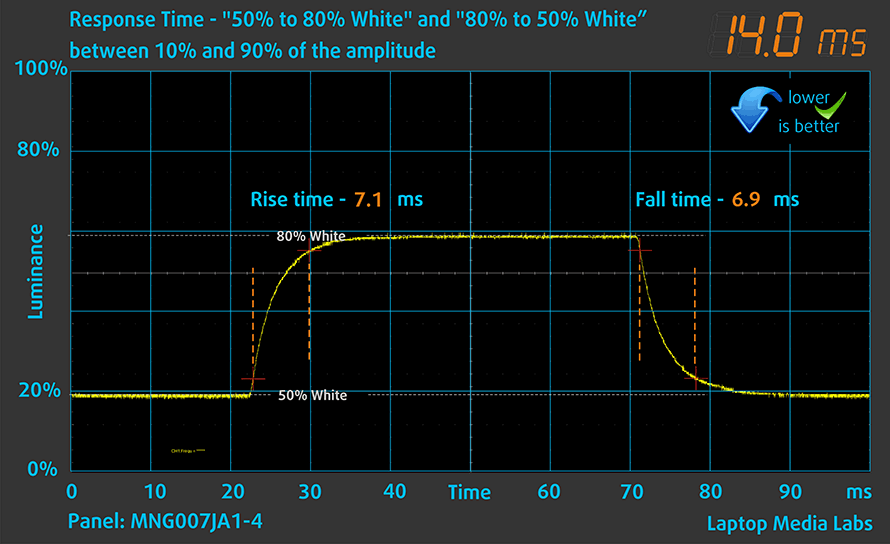
PWM (Screen flickering)
Pulse-width modulation (PWM) is an easy way to control monitor brightness. When you lower the brightness, the light intensity of the backlight is not lowered, but instead turned off and on by the electronics with a frequency indistinguishable to the human eye. In these light impulses, the light/no-light time ratio varies, while brightness remains unchanged, which is harmful to your eyes. You can read more about that in our dedicated article on PWM.
Lenovo Legion 5i Pro (16″, 2022)’s display doesn’t use PWM to adjust its brightness at any point. This means it is comfortable for long gaming sessions without harming your eyes in this aspect.
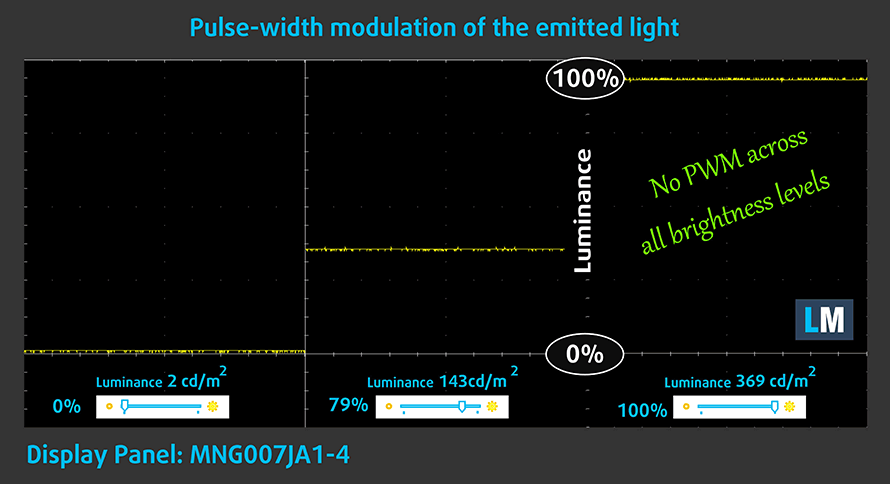
Blue light emissions
Installing our Health-Guard profile not only eliminates PWM but also reduces the harmful Blue Light emissions while keeping the colors of the screen perceptually accurate. If you’re not familiar with the Blue light, the TL;DR version is – emissions that negatively affect your eyes, skin, and your whole body. You can find more information about that in our dedicated article on Blue Light.
Gloss level measurement
Glossy-coated displays are sometimes inconvenient in high ambient light conditions. We show the level of reflection on the screen for the respective laptop when the display is turned off and the measurement angle is 60° (in this case, the result is 50.2 GU).
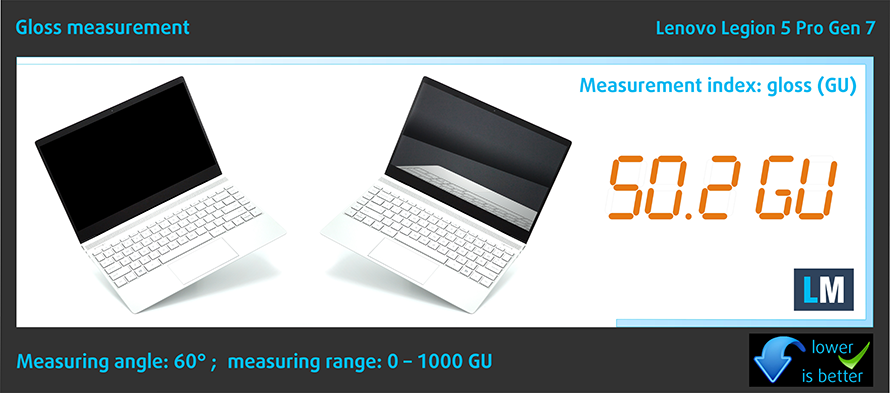
Buy our profiles
Since our profiles are tailored for each individual display model, this article and its respective profile package are meant for Lenovo Legion 5i Pro (16″, 2022) configurations with 16″ WUXGA IPS MNG007JA1-4 (CSO1613).
*Should you have problems with downloading the purchased file, try using a different browser to open the link you’ll receive via e-mail. If the download target is a .php file instead of an archive, change the file extension to .zip or contact us at [email protected].
Read more about the profiles HERE.
In addition to receiving efficient and health-friendly profiles, by buying LaptopMedia's products you also support the development of our labs, where we test devices in order to produce the most objective reviews possible.

Office Work
Office Work should be used mostly by users who spend most of the time looking at pieces of text, tables or just surfing. This profile aims to deliver better distinctness and clarity by keeping a flat gamma curve (2.20), native color temperature and perceptually accurate colors.

Design and Gaming
This profile is aimed at designers who work with colors professionally, and for games and movies as well. Design and Gaming takes display panels to their limits, making them as accurate as possible in the sRGB IEC61966-2-1 standard for Web and HDTV, at white point D65.

Health-Guard
Health-Guard eliminates the harmful Pulse-Width Modulation (PWM) and reduces the negative Blue Light which affects our eyes and body. Since it’s custom tailored for every panel, it manages to keep the colors perceptually accurate. Health-Guard simulates paper so the pressure on the eyes is greatly reduced.
Get all 3 profiles with 33% discount
Sound
Lenovo Legion 5i Pro (16″, 2022)’s speakers produce a sound of pretty good quality.
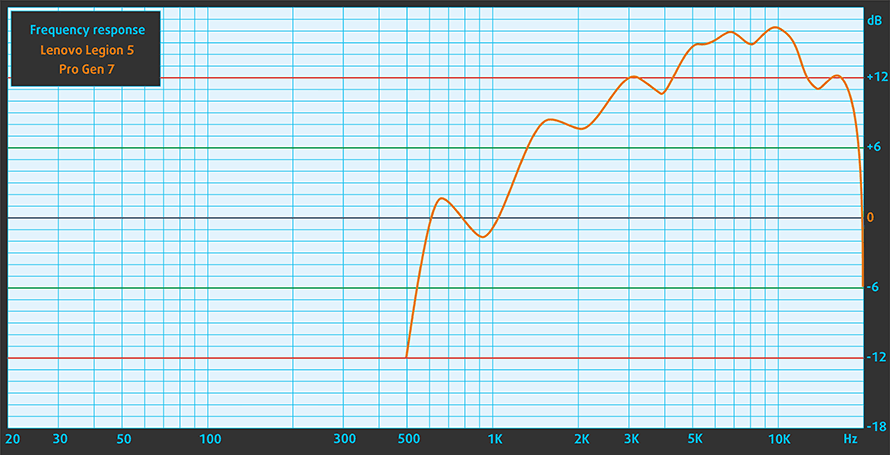
Drivers
All drivers and utilities for this notebook can be found here: https://pcsupport.lenovo.com/us/en/products/laptops-and-netbooks/legion-series/legion-5-pro-16iah7h/downloads/driver-list
Battery
Now, we conduct the battery tests with the Windows Better performance setting turned on, screen brightness adjusted to 120 nits, and all other programs turned off except for the one we are testing the notebook with. Here, the 80Wh battery lasts for 5 hours and 29 minutes of Web browsing, or 5 hours and 54 minutes of video playback.
In order to simulate real-life conditions, we used our own script for automatic web browsing through over 70 websites.
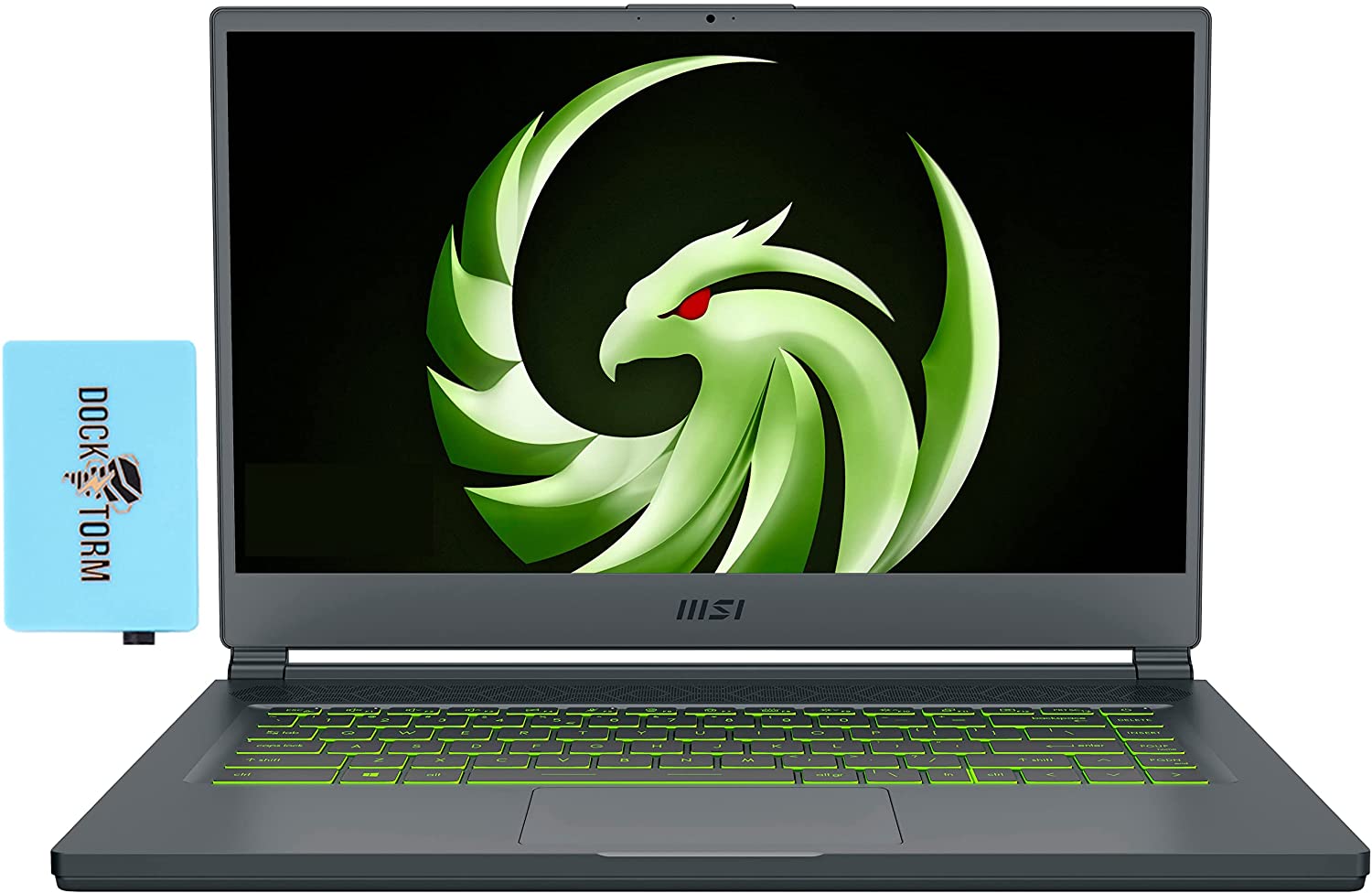
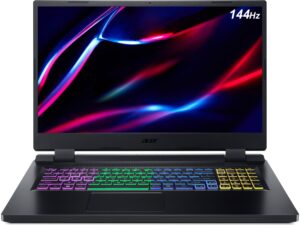

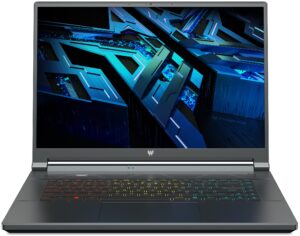
For every test like this, we use the same video in HD.




CPU options
Lenovo sells this notebook with the Core i5-12500H, Core i7-12700H, or Core i9-12900H.
Results are from the Cinebench R23 CPU test (the higher the score, the better)
Results are from our Photoshop benchmark test (the lower the score, the better)
GPU options
In terms of graphics, you can choose between the NVIDIA GeForce RTX 3050 Ti (95W), RTX 3060 (140W), RTX 3070 (150W), and RTX 3070 Ti (150W).
Results are from the 3DMark: Time Spy (Graphics) benchmark (higher the score, the better)
Results are from the 3DMark: Fire Strike (Graphics) benchmark (higher the score, the better)
Results are from the 3DMark: Wild Life benchmark (higher the score, the better)
Results are from the Unigine Superposition benchmark (higher the score, the better)
Lenovo Legion 5 Pro / 5i Pro (16" Intel, 2022) GPU variants
Here you can see an approximate comparison between the GPUs that can be found in the Lenovo Legion 5 Pro / 5i Pro (16" Intel, 2022) models on the market. This way you can decide for yourself which Lenovo Legion 5 Pro / 5i Pro (16" Intel, 2022) model is the best bang for your buck.
Note: The chart shows the cheapest different GPU configurations so you should check what the other specifications of these laptops are by clicking on the laptop’s name / GPU.
Results are from the 3DMark: Time Spy (Graphics) benchmark (higher the score, the better)
Results are from the 3DMark: Fire Strike (Graphics) benchmark (higher the score, the better)
Results are from the 3DMark: Wild Life (Graphics) benchmark (higher the score, the better)
Results are from the Unigine Superposition benchmark (higher the score, the better)
Gaming tests
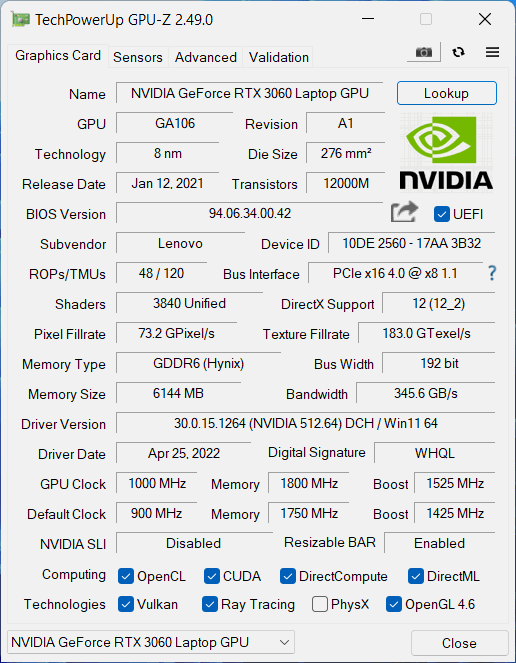
| Metro Exodus | Full HD, Low (Check settings) | Full HD, High (Check settings) | Full HD, Extreme (Check settings) |
|---|---|---|---|
| Average FPS | 139 fps | 74 fps | 37 fps |
| Borderlands 3 | Full HD, Medium (Check settings) | Full HD, High (Check settings) | Full HD, Badass (Check settings) |
|---|---|---|---|
| Average fps | 108 fps | 92 fps | 76 fps |
| Tom Clancy’s Ghost Recon Wildlands | Full HD, High (Check settings) | Full HD, Very High (Check settings) | Full HD, Ultra (Check settings) |
|---|---|---|---|
| Average | 113 fps | 97 fps | 64 fps |

| Shadow of the Tomb Raider (2018) | Full HD, Medium (Check settings) | Full HD, High (Check settings) | Full HD, Highest (Check settings) |
|---|---|---|---|
| Average | 129 fps | 124 fps | 83 fps |
[eBook Guide + Tools] How to MAX OUT your Lenovo Legion 5i Pro (16″, 2022)
Your Lenovo Legion 5i Pro (16″, 2022) can be Faster. LaptopMedia has tested thousands of models in the last 15 years, and we’re yet to see a notebook that couldn’t be made more powerful through modifications. And have you seen the most popular search on Google related to “how to make my …”? No? OK, here it is:

As you see, having a faster laptop is more important than having more hair.
Well, the main issue here is that there are thousands of advices on the Web. Some work, some don’t. Some are easy, some are complicated. Some are safe, and some are risky. If only there could be an Easy-to-Follow, Step-by-Step, and Laboratory-Tested guide by a proven organization, right?
That’s what we’ve done. We have hundreds of laptops scattered in our office, and we’ve spent a whole year testing different optimizations. We’ve chosen the ones that really make a difference, that are easy to implement without expert skills, and that are safe for your laptop in the long term.

🚀 What’s the performance boost I could expect?
There’s no general answer but we’ve reached more than 30% GPU Performance boost on some models, while typically it’s between 10% and 20%. You could always go beyond but we want to be sure that our advice will keep your laptop on the safe side in the long term. But you want to get the absolute maximum? We’ll show you how, and then it’s up to you.
We even set several World Records on 3DMark, one being our first Max Out for a specific laptop model – MSI Katana B13V.
We’d be happy to compete with YOU on the 3DMark rank lists, and see what YOUR laptop can do using our guide!
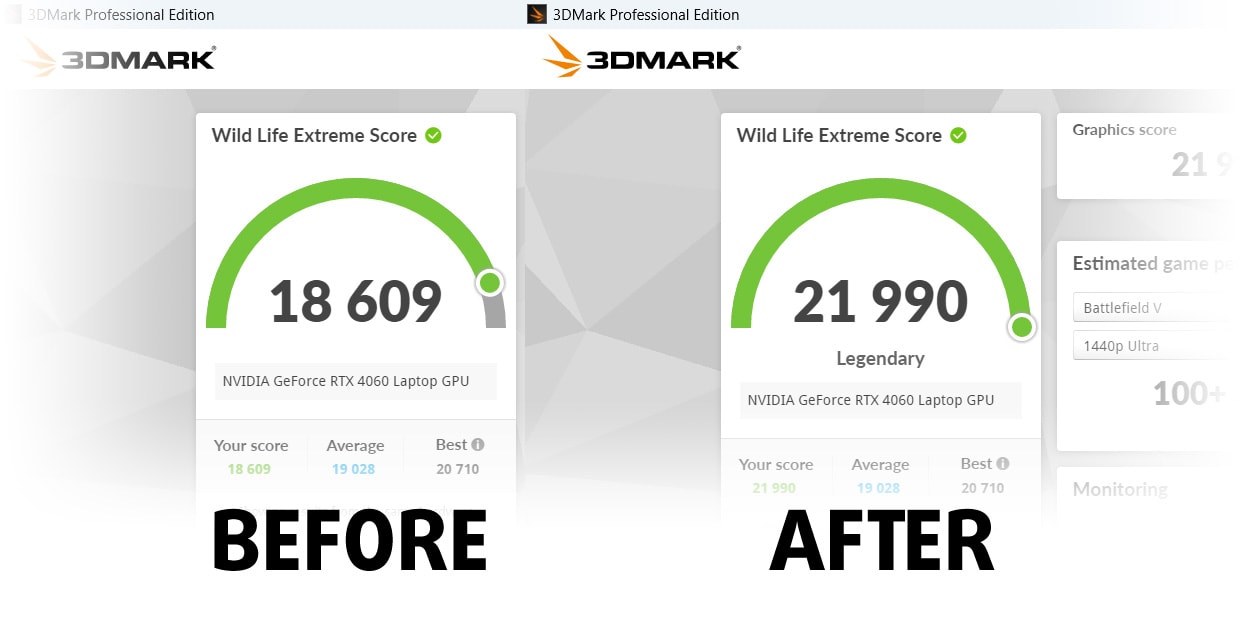
📦 What’s included?
📖 Our eBook includes All the tools you need, along with an Easy-to-follow guide for hassle-free:
⚡ GPU Performance boost by vBIOS replacement, Overclocking, and Undervolting
⚙️ Checking the hardware components and finding if you could get a significant boost by upgrading some of them
💾 Installing a clean Windows OS, with all the base settings you need
📋 Software optimization steps that really give a performance boost
⏩ Building a RAID Storage configuration for doubling sequential read/write speeds or protecting your data
🎯 Display Profiles bundle for a panel of your choice, enhancing the display for accurate colors, better experience, and protection of your eyes
🎁 To receive the Display Profiles bundle as a gift, simply email us your panel model through our “Contact Us” form.
💵 What is the price?
R&D on laptops isn’t easy nor cheap, especially when you’re not using cherry-picked review samples but real units instead. Our idea is to reinvest the profits from the sales back in our laboratory. However, we also want to make it a killer deal for everyone who is planning or has already spent on a gaming laptop, as this product would significantly boost the performance per dollar they get.

🛠️ GPU Modifications: vBIOS, Overclocking, Undervolting
⚙️ Building Fast/Reliable RAID configuration
💻 Hardware upgrade tips for best results
🖼 Display enhancing
💾 OS Optimization for best performance
✖ But if these optimizations are easy, why don’t manufacturers do them?
There are a lot of reasons for the manufacturers to put boundaries on your machine, locking part of its performance:
📊 Market Segmentation: To create different product tiers, manufacturers often limit performance. This allows them to target various market segments and price points, encouraging consumers to pay more for higher-performing models.
❓Unknown Potential: Each unit’s performance varies. Checking each one individually isn’t feasible.
🏢 Regulatory Compliance: Certain regions have regulations regarding energy consumption, and manufacturers often place some boundaries to fit all standards.
🏭 Supply Chain Constraints: Limitations are imposed due to the current availability of components.
🫰 Cost-effective solutions: Often, less popular but important details are overlooked. For example, better RAM types can boost performance by up to 30%, but many users ignore this, and many online stores don’t even provide that info.
🔒 Security concerns: Many protections impact performance while being negligible for regular users. However, manufacturers don’t know if their laptops will be purchased by individuals or large corporations, so they can’t disable these features by default.
Not a bad performance bump in terms of Storage Speeds:
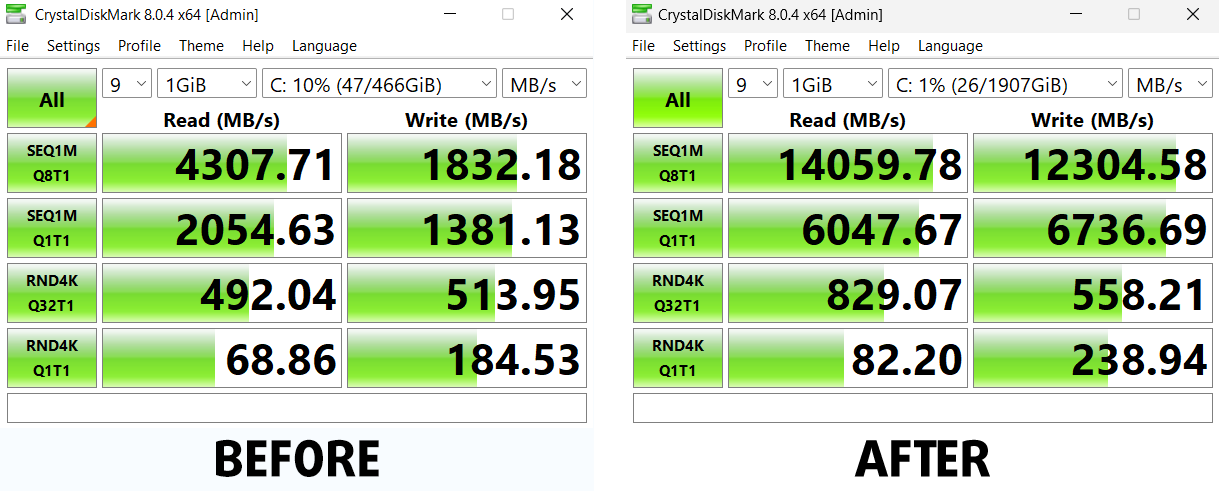
What are the default apps that impact performance the most?
What to do when RAID drives don’t show up?
How to optimize Windows further for maximum FPS gain in games?

Temperatures and comfort
Max CPU load
In this test we use 100% on the CPU cores, monitoring their frequencies and chip temperature. The first column shows a computer’s reaction to a short load (2-10 seconds), the second column simulates a serious task (between 15 and 30 seconds), and the third column is a good indicator of how good the laptop is for long loads such as video rendering.
Average P-core frequency; Average E-core frequency; CPU temp.; Package Power
| Intel Core i5-12500H (45W TDP) | 0:02 – 0:10 sec | 0:15 – 0:30 sec | 10:00 – 15:00 min |
|---|---|---|---|
| Lenovo Legion 5i Pro (16″, 2022) | 4.14 GHz @ 3.06 GHz @ 79°C @ 127W | 3.95 GHz @ 3.07 GHz @ 81°C @ 111W | 3.39 GHz @ 2.62 GHz @ 74°C @ 84W |
| Lenovo IdeaPad Gaming 3i (15″, 2022) | 3.88 GHz @ 3.03 GHz @ 75°C @ 104W | 3.76 GHz @ 2.93 GHz @ 80°C @ 94W | 3.16 GHz @ 2.37 GHz @ 70°C @ 66W |
| Acer Nitro 5 (AN515-58) | 3.77 GHz @ 2.83 GHz @ 75°C @ 98W | 3.92 GHz @ 3.00 GHz @ 80°C @ 101W | 2.85 GHz @ 3.07 GHz @ 80°C @ 85W |
Yes, there might be only a few devices we’ve tested with the Core i5-12500H, but we’ve never seen it reach 4.00 GHz. Surpassing this value is nothing short of impressive. Another interesting thing is to see the 127W power draw of the processor in the first 10 seconds of the torture test.
Real-life gaming
| NVIDIA GeForce RTX 3060 | GPU frequency/ Core temp (after 2 min) | GPU frequency/ Core temp (after 30 min) | Max Fans |
|---|---|---|---|
| Lenovo Legion 5i Pro (16″, 2022) | 1941 MHz @ 83°C @ 139W | 1920 MHz @ 86°C @ 138W | – |
| Lenovo Legion 5 (15″, 2022) | 1875 MHz @ 80°C @ 130W | 1863 MHz @ 82°C @ 130W | – |
| MSI Pulse GL76 (12Ux) | 1620 MHz @ 77°C @ 105W | 1608 MHz @ 81°C @ 105W | 1650 MHz @ 70°C @ 105W |
| ASUS ROG Strix G17 G713R (2022) | 1827 MHz @ 83°C @ 139W | 1825 MHz @ 85°C @ 139W | – |
| ASUS ROG Strix G15 G513R (2022) | 1844 MHz @ 81°C @ 139W | 1723 MHz @ 74°C @ 118W | – |
| ASUS TUF Gaming F17 (FX706, 2021) | 1548 MHz @ 80°C @ 95W | 1540 MHz @ 81°C @ 95W | – |
| HP Omen 17 (2021, 17-ck0000) | 1861 MHz @ 72°C @ 129W | 1857 MHz @ 73°C @ 130W | – |
| Lenovo ThinkBook 16p Gen 2 | 1535 MHz @ 69°C @ 75W | 1517 MHz @ 76°C @ 75W | – |
| Lenovo Legion 5i (17″ Intel, 2021) | 1886 MHz @ 75°C @ 127W | 1879 MHz @ 76°C @ 127W | – |
| Lenovo Legion 7 (16″, 2021) | 1867 MHz @ 70°C @ 126W | 1858 MHz @ 74°C @ 127W | – |
| Lenovo Legion 5 (15″ AMD, 2021) | 1831 MHz @ 75°C @ 129W | 1815 MHz @ 80°C @ 129W | – |
| Lenovo Legion 5 Pro (16″) | 1803 MHz @ 76°C @ 129W | 1787 MHz @ 81°C @ 129W | – |
| MSI GP66 Leopard | 1863 MHz @ 72°C @ 124W | 1852 MHz @ 75°C @ 125W | 1849 MHz @ 69°C @ 127W |
| MSI GP76 Leopard | 1860 MHz @ 71°C @ 129W | 1857 MHz @ 73°C @ 128W | 1869 MHz @ 67°C @ 128W |
When you let this laptop run at its maximum capacity, it will push the hardware to the limit. This leads to temperatures that sit a bit too high for comfort. Yet again, the core clock of the RTX 3060 nearly touches the 2.00 GHz mark.
Gaming comfort
Also, the outside remains pretty cool with a maximum temperature of about 42°C in the middle of the keyboard.
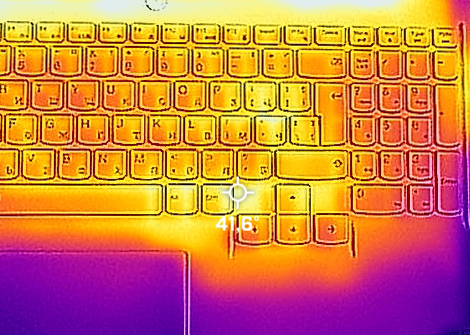
Verdict
 See, what Lenovo did with its 2022 version of the Legion 5i Pro is really bold. It has barely changed the cooling system but still provided 10W more to the GPU. This may lead to high temperatures but the RTX 3060 runs really stable. Even the Core i5-12500H is able to provide enough headroom for pretty much every game out there. In fact, this configuration is faster than the Core i7-11800H.
See, what Lenovo did with its 2022 version of the Legion 5i Pro is really bold. It has barely changed the cooling system but still provided 10W more to the GPU. This may lead to high temperatures but the RTX 3060 runs really stable. Even the Core i5-12500H is able to provide enough headroom for pretty much every game out there. In fact, this configuration is faster than the Core i7-11800H.
In addition to that, you will be met by a very extensive I/O. You get a lot of everything, with exception of an SD card reader, which is a bit unfortunate given the content creative nature of the laptop.
Speaking of which, Lenovo Legion 5i Pro (16″, 2022)’s IPS panel has a 1200p resolution, 16:10 aspect ratio, comfortable viewing angles, and a good contrast ratio. Also, it doesn’t use PWM for brightness adjustment, which makes it safe for long periods of use. Furthermore, it covers 97% of the sRGB color gamut, which is paired with a fantastic color accuracy when our Gaming and Web design profile is applied. For the gamers out there, you get a 165Hz refresh rate with quick pixel response times and G-Sync support.
In addition to these goodies, you also have the option to use the laptop in dGPU-only mode. This means that it does have a MUX switch, which connects the display directly to the discrete GPU, thus receiving all of the bandwidth available.
Unfortunately, this year’s Intel processors aren’t very efficient. Even the Legion 5 (15″, 2022) with its QHD display shows a significantly longer battery life, thanks to its AMD architecture. We are talking about 5 hours and 30 minutes of Web browsing for the Pro versus more than 15 hours for the AMD non-Pro. Yikes!
But if you don’t care about battery life, you must care about upgradeability. Here, you get two SODIMM slots for DDR5 memory, as well as two M.2 PCIe x4 slots, which support Gen 4 drives.
Ultimately, the difference between the Pro and the non-Pro models is not that big. It all falls down to the display, which offers more vertical space, supports G-Sync, and has a MUX switch for direct connection to the dedicated GPU. Everything else is simply fantastic – not to mention the keyboard, which is on another level.
We would definitely recommend this device, but keep in mind that if you want the performance – pick Intel, if you need long battery life and efficiency – AMD is the way to go.
You can check the prices and configurations in our Specs System: https://laptopmedia.com/series/lenovo-legion-5-pro-5i-pro-16-intel-2022/
Pros
- High TGP GPUs
- 2x M.2 PCIe x4 Gen 4 slots, 2x DDR5 RAM SODIMM slots in dual channel, Wi-Fi 6
- Covers 97% of the sRGB color gamut and has accurate color representation with our Gaming and Web design profile (MNG007JA1-4 (CSO1613))
- Snappy panel with quick response times (MNG007JA1-4 (CSO1613))
- G-Sync support + MUX switch
- Has a ton of ports
- Great input devices
- The keyboard remains relatively cool after long gaming sessions
- Good build quality
Cons
- No SD card
- Below average battery life
